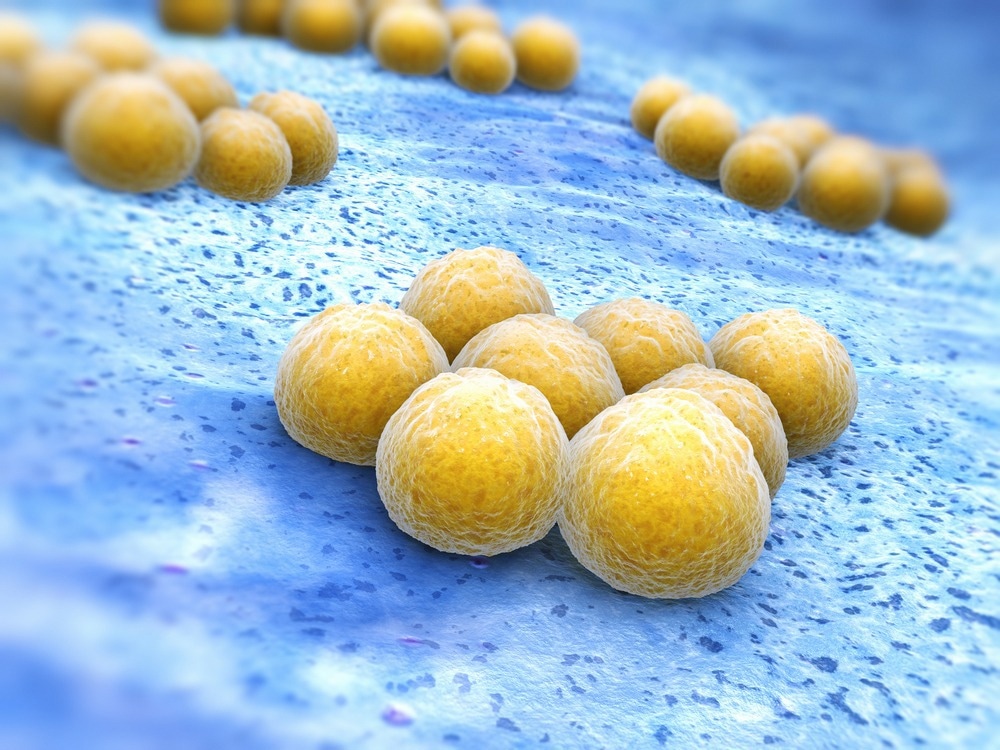In a recent study published in the American Journal of Physiology-Lung Cellular and Molecular Physiology, a group of researchers examined how heparan sulfate (HS)shedding impacts cathelicidin efficacy in Methicillin-Resistant Staphylococcus aureus (MRSA) pneumonia.
 Study: Bacterial pneumonia-induced shedding of epithelial heparan sulfate inhibits the bactericidal activity of cathelicidin in a murine model. Image Credit: Tatiana Shepeleva/Shutterstock.com
Study: Bacterial pneumonia-induced shedding of epithelial heparan sulfate inhibits the bactericidal activity of cathelicidin in a murine model. Image Credit: Tatiana Shepeleva/Shutterstock.com
Background
Pneumonia, particularly caused by MRSA, is a leading cause of infectious mortality. The mechanisms leading to Staphylococcal pneumonia are not fully understood. This study explores the interactions between MRSA, the pulmonary epithelial glycocalyx, and antimicrobial peptides (AMPs) in pneumonia.
The focus is on the HS enriched glycocalyx, a sulfated layer lining the alveoli known to bind cationic proteins. We examine the shedding of HS into the airspace following lung injury and its potential impact on lung function and interactions with AMPs. Specifically, we investigate how shed HS oligosaccharides, especially during bacterial pneumonia, interact with AMPs like cathelicidins, impacting the host immune response and pathogen dynamics.
Further research is needed to fully understand the mechanisms by which HS shedding impacts AMP function, offering potential for novel therapeutic strategies in pneumonia treatment.
About the study
In this study, following the University of Colorado's Institutional Animal Care and Use Committee (IACUC) and Animal Research: Reporting of In Vivo Experiments (ARRIVE) guidelines, male C57BL6 mice underwent intratracheal MRSA instillation, followed by bronchoalveolar lavage (BAL) for fluid analysis. Researchers used mass spectrometry to measure HS in BAL fluid, blind to treatment groups for objective results.
Additionally, the team innovatively collected airspace fluid from pneumonia patients using heat and moisture exchanger (HME) filters at Vanderbilt University Medical Center under an approved Institutional Review Board (IRB) protocol. This aimed to detect lung changes due to respiratory failure.
The study employed surface plasmon resonance (SPR) to examine the binding kinetics between AMP and HS, providing real-time, label-free interaction insights. Concurrently, bacterial growth curves were studied under various conditions to assess the effect of different heparin types on MRSA strains.
Detailed processes of bacterial ribonucleic acid (RNA) isolation and sequencing were conducted, involving MRSA culture in heparin or saline, followed by RNA extraction and sequencing. These steps were crucial in exploring transcriptomic changes and enhancing understanding of bacterial pneumonia dynamics.
The research also included minimum inhibitory concentration (MIC) quantification for different pneumonia pathogens against AMP in varying HS concentrations. This was key in evaluating how HS influences AMP effectiveness against bacterial infections. Rigorous statistical analysis ensured the study's findings were reliable and valid.
Study results
In the present study, researchers utilized a murine model of MRSA pneumonia. Mass spectrometry analyses revealed a significant increase in HS in the airspace lining fluid of MRSA-infected mice compared to saline controls. Notably, this increase was characterized by a higher abundance of sulfated HS, particularly multi-sulfated disaccharides. Complementary analyses with HME filter samples indicated higher HS levels in patients with gram-negative pneumonia compared to those with gram-positive pneumonia, suggesting a nuanced relationship between bacterial etiology and HS shedding.
Despite the observed increase in shed HS in the lung environment, the study found no direct impact of HS on MRSA growth or gene transcription. Experiments involving various sizes and sulfation patterns of HS showed no significant changes in MRSA growth or transcriptomic response. This finding suggested that HS, while a significant component of the lung milieu post-injury, did not directly inhibit bacterial growth or induce changes in bacterial gene expression.
The study further delved into the interactions between HS and host immune mediators. Using surface plasmon resonance (SPR), the researchers quantified the binding of HS with murine cathelicidin-related antimicrobial peptide (mCRAMP). The strong binding observed indicated a likely interaction in vivo, which could potentially influence the host response to bacterial infection.
Most critically, the study investigated the functional implications of HS binding to mCRAMP. Focusing on common nosocomial pneumonia pathogens including MRSA, Klebsiella pneumoniae, and Pseudomonas aeruginosa, the research employed a modified radial diffusion assay to assess the MIC of mCRAMP against these bacteria.
Results showed significant increases in MIC with higher HS concentrations, indicating a diminished bactericidal effect of mCRAMP in the presence of HS. This finding was particularly noteworthy as it highlighted the complex interplay between HS and host defense mechanisms, where HS, despite not directly affecting MRSA growth, significantly altered the efficacy of an antimicrobial peptide.
Conclusion
Overall, the study underscored the intricate dynamics within the pulmonary environment following bacterial pneumonia. The acute shedding of epithelial HS, particularly when enriched in sulfated forms, presented a nuanced challenge to the host's immune response, potentially influencing the effectiveness of innate immune mechanisms against bacterial pathogens.